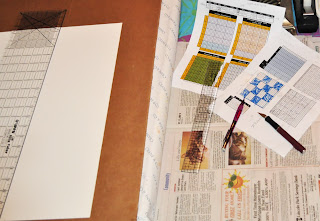After some trial and error I finally found a technique that worked for me and I'm sharing it with you today to hopefully save someone else from all the trouble and frustration that I dealt with during my first glass etching attempts!
Supplies Needed:
- Cricut Machine
- Software program to cut from your computer to the Cricut
- Transfer Tape (I've also had success using regular sticker paper or Avery adhesive labels)
- Armour Etch
- Glass paint
- Masking Tape
- Paint Brushes
- Glass Item
- Alcohol
- Optional: Bone Folder (not pictured)
 I used my favorite dingbat font ever, Hibiscus, for the stencil and cut it out using the Cricut with the speed and pressure set at medium and a blade depth of 4.
I used my favorite dingbat font ever, Hibiscus, for the stencil and cut it out using the Cricut with the speed and pressure set at medium and a blade depth of 4.I found it was easiest to start in the middle and work my way out when adhering the stencil to the glass. Once it's fully adhered, run the bone folder (or handle of the paintbrush) over all of the edges and make sure there are no creases or gaps. This is super important! The Armour Etch is sneaky and can get under even the tiniest gaps, ruining your nice crisp edges.
After everything is adhered and smoothed, tape all around the stencil with the masking tape. Not so much for fear of painting the etching cream outside the lines, but to protect the rest of the glass from "etching bloom" as I call it, when you are rinsing the etching cream off. Another thing I wish I had known during my first attempts - even when you are rinsing the glass, any etching cream that touches the unetched areas, even for a second, will create a cloudy splotch.
Be generous when applying the cream to the glass! You want a nice, smooth and even application. To double check the application, hold the glass up to light and look through the backside of it - any areas that need more cream will be easy to spot.
Because I thought it needed some color and glitter (of course), I finished the glass by applying 2 coats of paint and 1 coat of glitter glass paint to the bottom and stem of the goblet. I don't know if it was the shape or the texture, but in order to get a full, even coverage of paint with no streaks, the 2nd coat was really important.
Once you get the hang of it, the possibilities are endless - monogrammed wine glasses, votive holders, ornaments, holiday gifts, etc!












